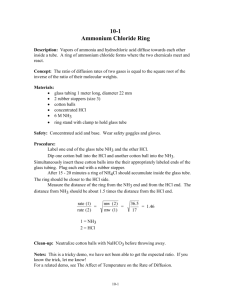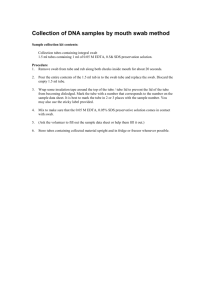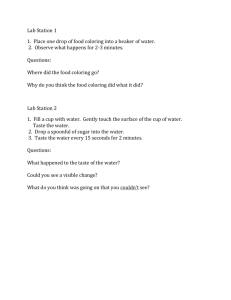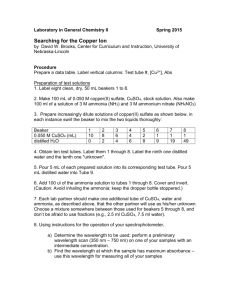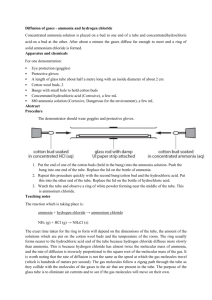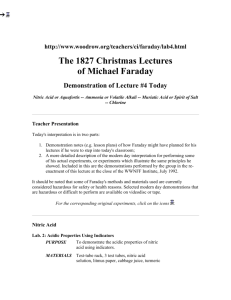graham*s law extra name - Salem Community Schools
advertisement
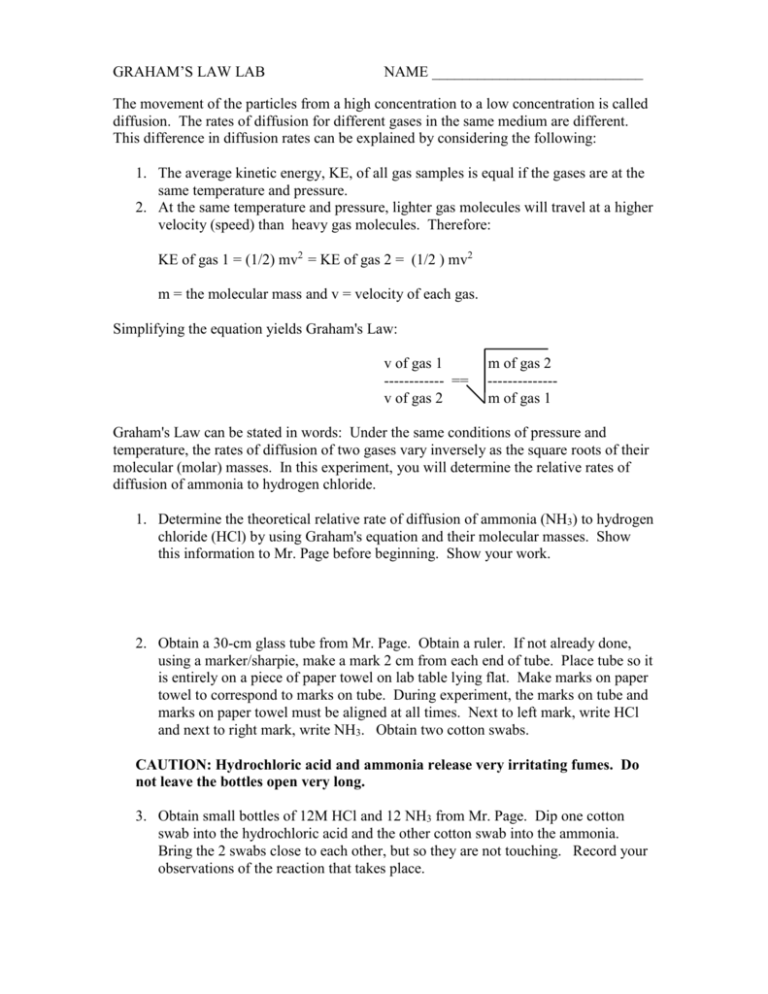
GRAHAM’S LAW LAB NAME ____________________________ The movement of the particles from a high concentration to a low concentration is called diffusion. The rates of diffusion for different gases in the same medium are different. This difference in diffusion rates can be explained by considering the following: 1. The average kinetic energy, KE, of all gas samples is equal if the gases are at the same temperature and pressure. 2. At the same temperature and pressure, lighter gas molecules will travel at a higher velocity (speed) than heavy gas molecules. Therefore: KE of gas 1 = (1/2) mv2 = KE of gas 2 = (1/2 ) mv2 m = the molecular mass and v = velocity of each gas. Simplifying the equation yields Graham's Law: v of gas 1 ------------ == v of gas 2 m of gas 2 -------------m of gas 1 Graham's Law can be stated in words: Under the same conditions of pressure and temperature, the rates of diffusion of two gases vary inversely as the square roots of their molecular (molar) masses. In this experiment, you will determine the relative rates of diffusion of ammonia to hydrogen chloride. 1. Determine the theoretical relative rate of diffusion of ammonia (NH3) to hydrogen chloride (HCl) by using Graham's equation and their molecular masses. Show this information to Mr. Page before beginning. Show your work. 2. Obtain a 30-cm glass tube from Mr. Page. Obtain a ruler. If not already done, using a marker/sharpie, make a mark 2 cm from each end of tube. Place tube so it is entirely on a piece of paper towel on lab table lying flat. Make marks on paper towel to correspond to marks on tube. During experiment, the marks on tube and marks on paper towel must be aligned at all times. Next to left mark, write HCl and next to right mark, write NH3. Obtain two cotton swabs. CAUTION: Hydrochloric acid and ammonia release very irritating fumes. Do not leave the bottles open very long. 3. Obtain small bottles of 12M HCl and 12 NH3 from Mr. Page. Dip one cotton swab into the hydrochloric acid and the other cotton swab into the ammonia. Bring the 2 swabs close to each other, but so they are not touching. Record your observations of the reaction that takes place. 4. READ ENTIRE STEP BEFORE PROCEEDING: Dip the swabs into the hydrochloric acid and ammonia again. At the same time, while keeping the marks on tube and paper towel aligned, push swab with HCL into left end of the glass tube up to mark and push swab with NH3 into right end of the glass tube up to the mark. It is important the push the swabs into the glass at the same time. Leave the glass tube on the paper towel so marks are aligned and do not move it. You will eventually see the reaction you observed earlier because the gases are diffusing towards each other. You will see a white ring start to form somewhere between the two marks on tube. It is very subtle at first so be attentive. It may take 2-5 minutes. Watch very carefully because you want to mark a spot on paper towel where you first see the reaction. 5. You should measure distance to nearest 0.1 cm. On paper towel, measure the distance, dHCl (in cm), from left mark to middle mark which is the distance the HCl traveled: ___________ cm Measure the distance, dNH3 (in cm), from right mark to middle mark which is the distance the NH3 traveled: ___________ cm 6. Check: measure the distance between right and left mark. Is this equal to dHCl + dNH3 ?. They should be very close. If not, re-measure. If you still have trouble, see Mr. Page. 7. Rinse glass tube with tap water (inside and out), dry outside, and return it to Mr. Page. Place the cotton swabs in the trash, and return 12M HCl and 12M NH3 bottles to Mr. Page. 8. Since the time of travel was the same for the HCl and NH3, you can use the distance measurements as rates. Calculate the ratio of the rate of NH3 to the rate of HCl. Show your work. 9. Compare your experimental rate to the theoretical rate you calculated in step 1. Calculate a percent error. Show your work. 10. Determine the theoretical relative rate of diffusion of helium to carbon dioxide. Show your work. 11. A certain gas diffuses four times as fast as oxygen. What is the molar mass of the gas? Show your work.

